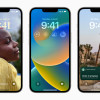Review: Samsung DoubleTime for AT&T
The DT doesn't pretend to be anything other than what it is: A simple(r) smartphone for people who really want a platform for sending messages. The sideways clamshell design is blocky, uses lower-grade materials, and comes across as utilitarian. Most of the outer shell is made of white plastics, though the display and bezel are black. It vaguely reminds me of the E.V.E. robot from the movie Wall-E.
The DT is a chunky device and has some good heft to it. It feels solid enough to hurt someone were it to be thrown (but please don't do that). Despite the plastic materials, the build quality is excellent. It feels somewhat rugged and strong enough to take some abuse. It's comfortable to grip in the hand, though it's a bit thick for stuffing into pockets. You'll be able to squeeze it in there, but it's going to be obvious to others what's in there.
The display takes up perhaps 75% of the DT's front surface. Below that are four hardware keys for accessing the Android controls. These buttons have an excellent feel to them, and the perfect amount of travel and feedback.
The volume toggle is on the left edge of the phone. It's a thin key that has a stiff feel to it. I don't love it, but it's not the worst volume toggle ever. The microUSB port is on the bottom of the DT, while the 3.5mm headset jack and power/lock button are on top. The power/lock button is way too small and too flush with the surface of the DT. It also has poor travel and feedback. The DT lacks a dedicated camera button.
As with many sideways clamshells, the DT opens to two different angles: about 120 degrees for comfortable typing (think miniature laptop), and about 170 degrees for comfortable picture taking. The hinge feels very strong and the open/closing action works really well.
When open, the DT offers a second, roomy display and full QWERTY keyboard for messaging. The four Android control keys are duplicated above the keyboard, which is an odd location if you ask me; I'd prefer to have them built into the bottom row of the keyboard. There is no dedicated row for numbers, though the bottom row offers access to the microphone, ".com" and "www" shortcuts, as well as period, comma, space bar, and question mark keys. There is also a set of arrow keys for on-screen editing, even though the secondary screen is also a touch display.
The buttons themselves are almost perfectly flat and have practically no definition. It's really hard to tell where your thumbs are as they dance from key to key. The one saving grace is that the keys have excellent travel and feedback. I wish the keys had more shape to them. I found it hard to type on this keyboard, which sort of negates the point of having one on a device that also offers a software keyboard. It could be a lot better.
The battery cover is easily removed, and the SIM card can be swapped out without removing the battery. The microSD slot, however, is buried next to the battery, so you won't be able to hot-swap memory cards.















 Hands-On: Samsung DoubleTime
Hands-On: Samsung DoubleTime
 AT&T Announces Five New Android Smartphones
AT&T Announces Five New Android Smartphones
 Hands On with the HMD Fusion and its Smart Outfits
Hands On with the HMD Fusion and its Smart Outfits
 iOS 16 Revamps the Lock Screen
iOS 16 Revamps the Lock Screen
 Samsung DoubleTime
Samsung DoubleTime











